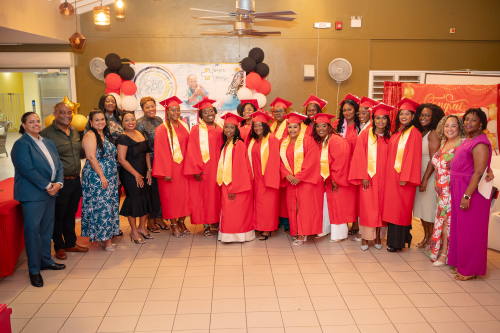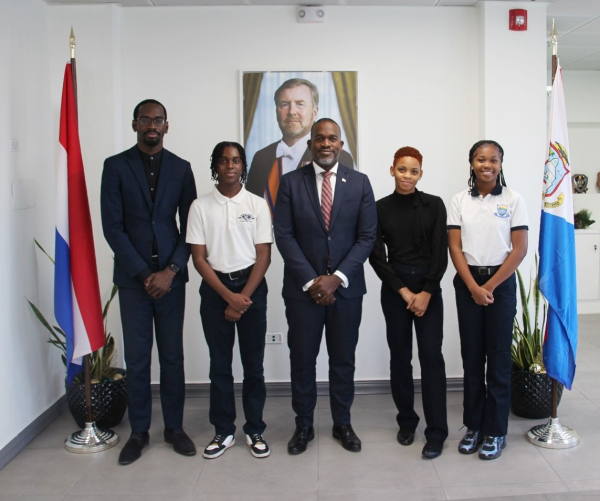 PHILIPSBURG:--- On December 19, the White & Yellow Cross Care Foundation (WYCCF) proudly celebrated the graduation of fourteen employees from the Sister Basilia Center (SBC), all of whom successfully completed their accredited Social Pedagogic Worker (SPW) Level 4 diploma.
PHILIPSBURG:--- On December 19, the White & Yellow Cross Care Foundation (WYCCF) proudly celebrated the graduation of fourteen employees from the Sister Basilia Center (SBC), all of whom successfully completed their accredited Social Pedagogic Worker (SPW) Level 4 diploma.
The graduates are: Davila Smith, Marya Morrison, Roumelta Gumbs, Vanessa Mclean, Rhunella Nicolaas, Shemiqua Lake, Raquill Brooks, Hendricia Hodge, Christine Powell, Loeann Thompson, Richaline Wilson, Rhode Jean-Louis, Shardina Cannonier and Chanicha David.
The SPW 4 program followed a learning-while-working model and ran from February to December 2025. Participants received online live classes twice per week through Eligia Martier SBO School in Curaçao, while completing their internships and practical training directly at the Sister Basillia Center. Eligia Martier, founded in 1967, specializes in education for the healthcare and social welfare sectors and places the student at the center of its educational approach. The school is led by director Ms. Diachola Hinkel.
This program marked the first collaboration between WYCCF and Eligia Martier to deliver an accredited diploma program for SBC employees, representing an important milestone in strengthening staff development and enhancing the quality of care provided to clients.
The graduation ceremony was attended by 13 of the 14 graduates, members of the SBC and WYCCF Management Teams, the Human Resources team, colleagues, family members, and friends. The evening was further honoured by the presence of the Honourable Minister of Education, Culture, Youth and Sports, Ms. Melissa Gumbs, and was guided by Master of Ceremony and WYCCF Board member Mr. Marcel Gumbs.
During the ceremony, a message of perseverance and growth resonated strongly:
“Moving forward, remember: we strive for progress, not perfection. Keep moving forward, even when it’s tough. The SBC graduates have proven that perseverance leads to success, and tonight is living proof of that.”
WYCCF congratulates all graduates on this significant achievement and remains committed to investing in education, professional growth, and continuous learning across the organization.






 PHILIPSBURG:--- Small donations from across St. Maarten raised a total of US$5,601.47 to support relief efforts in Jamaica following Hurricane Melissa, which struck the island on October 28, 2025, through a public fundraising initiative led by the Buddhist Compassion Relief Tzu Chi Foundation St. Maarten.
PHILIPSBURG:--- Small donations from across St. Maarten raised a total of US$5,601.47 to support relief efforts in Jamaica following Hurricane Melissa, which struck the island on October 28, 2025, through a public fundraising initiative led by the Buddhist Compassion Relief Tzu Chi Foundation St. Maarten. PHILIPSBURG:--- The Tax Administration hereby informs taxpayers that due to an administrative error, a number of “Jaar aanslagen 2020” for Wage Tax and the Premiums AOV/AWW and AVBZ were mistakenly issued.
PHILIPSBURG:--- The Tax Administration hereby informs taxpayers that due to an administrative error, a number of “Jaar aanslagen 2020” for Wage Tax and the Premiums AOV/AWW and AVBZ were mistakenly issued. HARBOUR VIEW, PHILIPSBURG:--- His Excellency Governor Ajamu G. Baly met with the winner and finalists of the Youth Creative Vision Contest, organized in connection with the 2025 Governors Symposium under the theme “15 Years of Constitutional Autonomy: Achievements, Lessons and Prospects.” The informal meeting took place at the Cabinet of the Governor in Harbour View.
HARBOUR VIEW, PHILIPSBURG:--- His Excellency Governor Ajamu G. Baly met with the winner and finalists of the Youth Creative Vision Contest, organized in connection with the 2025 Governors Symposium under the theme “15 Years of Constitutional Autonomy: Achievements, Lessons and Prospects.” The informal meeting took place at the Cabinet of the Governor in Harbour View. During the informal meeting, the students shared their experiences researching and preparing their submissions. They highlighted the need for greater civic education and for greater emphasis on Sint Maarten’s history in school curricula. They also had the opportunity to ask His Excellency questions about his role as Governor and his outlook for the future of Sint Maarten.
During the informal meeting, the students shared their experiences researching and preparing their submissions. They highlighted the need for greater civic education and for greater emphasis on Sint Maarten’s history in school curricula. They also had the opportunity to ask His Excellency questions about his role as Governor and his outlook for the future of Sint Maarten.





